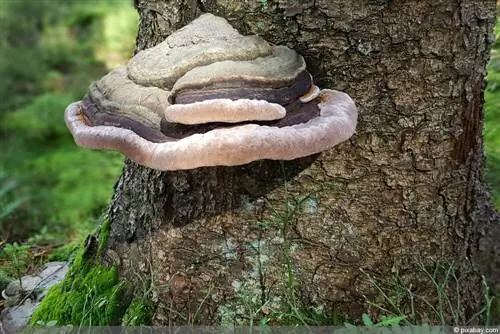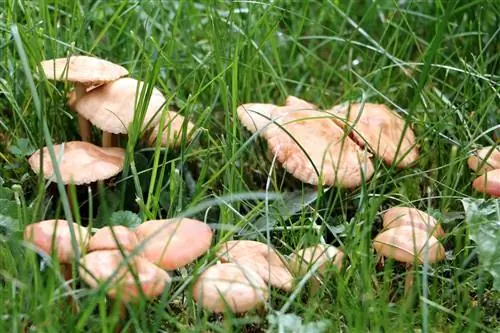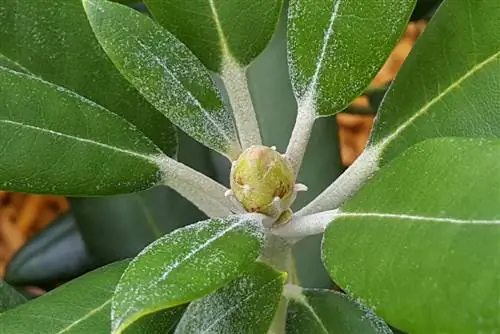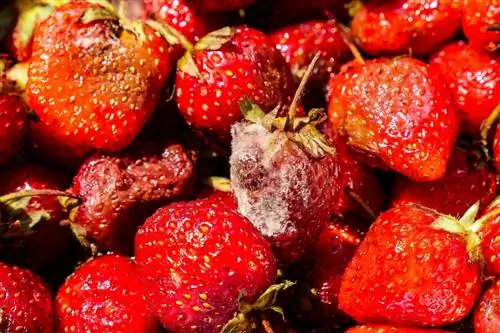- Author admin [email protected].
- Public 2023-12-17 03:39.
- Last modified 2025-01-24 12:45.
Tree fungi are by no means always as harmless as external appearances suggest. Many of the numerous varieties can seriously threaten the life of the tree. When the fruiting body appears on the trunk, the fungal network inside the trunk has already been eating away at the wood for years. Is it too late for rescue measures? Or can the fungus be driven away while the tree is still alive?
Meaning and occurrence of tree fungi
Tree fungi are very important for the earth's ecosystem and can therefore be found everywhere in nature. Countless species help to break down dead wood and thus provide new building material. They clean up, so to speak, and thereby contribute to maintaining the cycle of life.
- Spread via numerous fungal spores
- these are scattered from the visible fruiting body
- the mycelium (mushroom network) grows in secret for years
The problem with tree fungi is that some species also attack a living tree and also decompose its he althy wood, albeit slowly. They don't stop at trees that are in our private gardens.
White rot, brown rot and soft rot
The fungal species differ in their degradation behavior and are roughly divided into three groups:
White rot
White rot causes the wood component lignin to decompose. The wood becomes lighter, softer and fibrous. It swells and therefore increases in volume.
Brown rot
Brown rot, on the other hand, breaks down cellulose, which leads to brown discoloration in the wood. First it breaks into pieces and later completely turns into dust.
Soft rot
Soft rot decomposes even very wet wood and appears similar to brown rot.
Tree fungi are diverse
While the fungal network spreads through the wood and does its work purposefully, it remains hidden from our eyes. Years can pass from the time the tree is infected to the first visible sign, the fruiting body. He also reveals which fungus is in the wood. Since the species-rich family of tree fungi has more than 1,000 species, a hobby gardener will rarely recognize the type of mushroom right away.
Colorful fruiting body as a clue
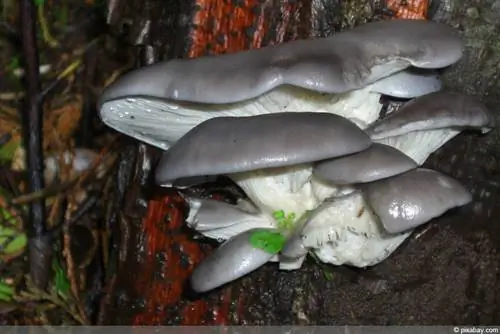
The fruiting bodies of tree mushrooms are usually colorful and interestingly shaped. They are often so large that they are hard to miss. If a fruit tree in the garden shows such a fruiting body on the tree trunk, its appearance helps to identify the type of fungus. Various image databases on the Internet can be searched to discover a match with the local copy. Since some types of mushrooms are more common, it makes sense to consider them first:
- Oyster mushroom
- Hallimasch, also called honey mushroom
- Sulphur Porling
- Red-edged Tree Sponge
- tinder fungus
When the fungus strikes
Living trees are not necessarily infected through contact with fungal spores. A he althy tree is well protected against such a threat. The situation is different with weak or diseased trees. If the spores are also provided with an open entry gate, the conditions for fungal colonization are optimal.
Living with the tree fungus
If the tree owner has discovered the fruiting body and thereby clearly identified the fungus, his hands are still largely tied. If the fruiting body is removed, it will do very little to help the infected tree, because the fungal network inside causes the damage. However, effective control of the fungal network is not possible for two reasons, even if clever fungicide suppliers occasionally claim this.
- the mushroom network is difficult to access inside
- the wood has been irreversibly damaged for years
How the fungal infection progresses and what effects it has on the tree also depends on the type of fungus. However, the fact that a tree can continue to live with a tree fungus for years brings some comfort. Fruit trees can even continue to produce tasty fruit. The tree still has a life ahead of it, albeit a disturbed or shorter one.
Sensible measures
While the life of an infected tree is slowly coming to an end, you don't just have to watch it idly. For example, if the fruiting body appears on a side branch, pruning can add a few years to the life of the tree.
- Remove the affected branch generously
- cut into he althy wood
- dispose of cut tree parts or burn them
By removing the branch you can combat a large part of the fungal network. This significantly reduces the infestation pressure.
Tip:
Disinfect cutting tools thoroughly before and after cutting to prevent further transmission.
Prevent spread
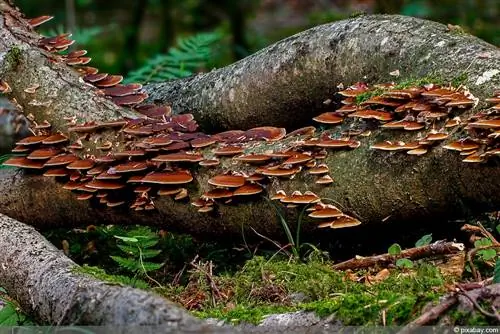
Removing the fruiting body does not help the infected tree itself, but it can help protect other trees in the garden. The spores ripen in the fruiting body and contain the potential for new tree fungi.
- Remove fruiting bodies
- immediately after discovery
- before the spores become ripe
Tip:
The fruiting body does not belong in the compost heap, but in the residual waste. If there are mature spores in it, they cannot be dangerous.
Prevention is the best protection
If you discover a tree fungus on a tree trunk, it is too late for this tree because you cannot effectively combat the fungal infection. What you can do, however, is to protect the trees that are still he althy. This is done by keeping them he althy and resilient through species-appropriate living conditions.
- check regularly for diseases and pests
- Fight these early with appropriate measures
- if applicable Grow robust or resistant varieties
When planting, pay attention to the optimal location where the tree can thrive in a species-appropriate manner. Find out about his care needs so that he can receive the best possible care year after year.
Be careful when cutting
Pruning fruit trees is often unavoidable, be it to improve crown structure, to promote fruit production or as a measure for various diseases. But every pruning measure also leaves open interfaces through which fungal spores can get into the interior of the tree unhindered.
- only cut if absolutely necessary
- Inform about suitable cutting techniques
- use sharp and disinfected cutting tools
- Keep cutting surfaces as small as possible
- cut on dry days
- if applicable Seal cut surfaces “professionally”
Not only cutting with pruning shears leaves open wounds, mowing the lawn can also lead to injuries to the tree trunk, through which fungal spores can then penetrate. Be careful not to damage roots when digging.
Check stability
The longer the mycelium gnaws on the tree trunk, the faster the tree loses stability. However, a rotten tree can easily fall over and cause serious damage. Yes, it can even hurt people and animals. But the stability of a tree cannot necessarily be seen from the outside.
- if applicable Hire a tree expert or tree inspector
- necessary investigations are being carried out
- the stability is determined in such a well-founded way
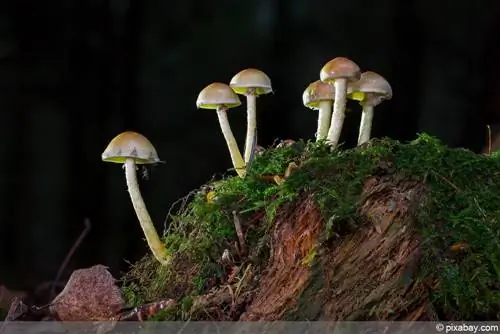
A tree appraiser costs money, but the expense can be worth it. The damage caused when a tree falls can be many times that amount. This is especially the case if the tree is close to buildings.
Cutting down and clearing trees
If a tree in the garden has been so damaged by long-term fungal infestation that it no longer has sufficient stability, it must be felled. It also makes sense to remove the roots from the soil straight away.
- Not all trees may be felled on your own
- official approval is required for some copies
- ask the municipal administration
Don't worry, if there is a rotten tree that poses a danger, permission will be granted without any problems.
Let die in peace until the “last wooden cell”
If a diseased tree does not pose a danger, it can remain in the garden until the last remnants are eliminated by nature. If you can get comfortable with a rotten tree trunk, leave it where it is. Numerous tiny creatures will love it and find shelter or food in it.
- if applicable consider it as a design element
- for example, green with climbing plants
- flowering climbing plants that grow quickly are also ideal

